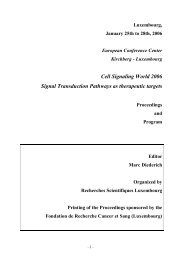Abstract book (download .pdf file) - Redox and Inflammation ...
Abstract book (download .pdf file) - Redox and Inflammation ...
Abstract book (download .pdf file) - Redox and Inflammation ...
You also want an ePaper? Increase the reach of your titles
YUMPU automatically turns print PDFs into web optimized ePapers that Google loves.
p75NTR regulates A! deposition by increasing A! production but inhibiting A!<br />
aggregation with its extracellular domain<br />
Xin-Fu Zhou, Xin Wang, Jian-Jun Lu, Qiao-Xin Li, Chang-Yue Gao, Xiao-Hong Liu,<br />
Yin Sun, Miao Yang, Yoon Lim, Genevieve Evin, Jin-Hua Zhong, Hua-Dong Zhou, Yan-<br />
Jiang Wang<br />
Department of Human Physiology <strong>and</strong> Centre for Neuroscience, Flinders University<br />
GPO Box 2100, Adelaide, South Australia<br />
Accumulation of toxic amyloid-beta (A!) in the cerebral cortex <strong>and</strong> hippocampus is a major<br />
pathological feature of Alzheimer’s disease (AD). The neurotrophin receptor, p75NTR, has<br />
been proposed to mediate A!- induced neurotoxicity; however its role in the development of<br />
AD remains to be clarified. The p75NTR/ExonIII-/- mice <strong>and</strong> APPSwe/PS1dE9 mice were<br />
crossed to generate transgenic AD mice with deletion of p75NTR gene. Study of p75NTR<br />
immunoreactivity in the AD model APPSwe/PS1dE9 transgenic mice, indicates its<br />
localization to the basal forebrain neurons <strong>and</strong> degenerative neurites in amyloid plaques of<br />
neocortex, increase with aging, <strong>and</strong> further activation by A! accumulation. Deletion of the<br />
p75NTR gene by crossing APPSwe/PS1dE9 mice with p75NTR knockout mice reduced<br />
soluble A! levels in the brain <strong>and</strong> plasma, but increased the accumulation of insoluble A! <strong>and</strong><br />
A! plaque formation. There was no change in the levels of amyloid precursor protein (APP)<br />
<strong>and</strong> its proteolytic derivatives, or ", ! <strong>and</strong> # secretase activities, or in levels of BACE1,<br />
neprilysin (NEP) <strong>and</strong> insulin degrading enzyme (IDE) proteins. Recombinant extracellular<br />
domain of p75NTR attenuated the oligomerization <strong>and</strong> fibrillation of synthetic A!42 peptide<br />
in vitro, <strong>and</strong> reduced local A! plaques after hippocampus injection in vivo. In addition,<br />
deletion of p75NTR attenuated microgliosis but increased the microhemorrhage pro<strong>file</strong>s in<br />
the brain. The deletion of p75NTR did not significantly change the cognitive function of the<br />
mice up to the age of 9 months. Our data suggest that p75NTR plays a critical role in<br />
regulating A! levels by both increasing A! production <strong>and</strong> attenuating its aggregation <strong>and</strong><br />
they caution that a therapeutic intervention simply reducing p75NTR may exacerbate AD<br />
pathology.<br />
59




